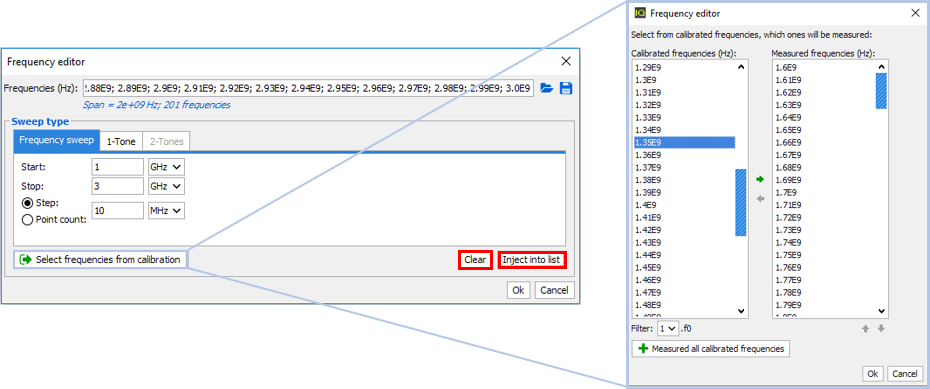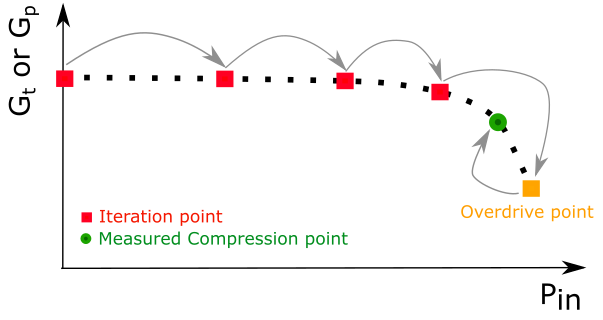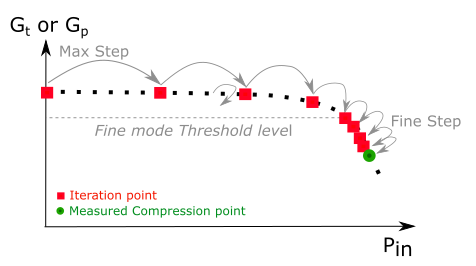I/Q Measurement Panel: Sweep Settings
Sweep setting is used to define two nested loops sweep in function of power and frequency using different acquisition mode.
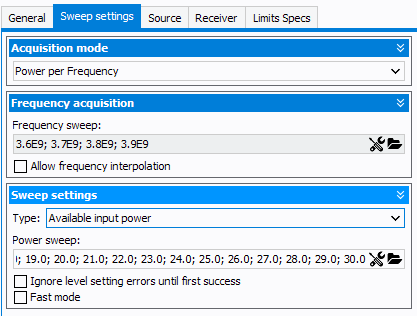
Acquisition mode:

- Power per Frequency: for each frequency acquisition, a ramp of RF power
will be sent to the DUT.

- Smart measurement is an advanced power per frequency mode. The ramp of
power is not linear but adaptive to achieve a targeted value.

Fequency Sweep Settings

- Frequency sweep (Hz): the calibration frequency list will be set by
default. Click on
 icon to open the 'Frequency editor' and modify the
frequency listNote: 'Frequency editor' is a tool used to define frequency sweeps or frequency segments. Click on 'Clear' or 'Inject into list' to add or remove frequencies. It is possible to select the frequencies available in the selected calibration file by clicking on 'Select frequencies from calibration'. It's also possible to save or load a frequency list (*.freq files) using
icon to open the 'Frequency editor' and modify the
frequency listNote: 'Frequency editor' is a tool used to define frequency sweeps or frequency segments. Click on 'Clear' or 'Inject into list' to add or remove frequencies. It is possible to select the frequencies available in the selected calibration file by clicking on 'Select frequencies from calibration'. It's also possible to save or load a frequency list (*.freq files) usingicons.
- Allow frequency interpolation: if the list of RF stimulus frequencies is different from the calibrated one, IQSTAR will interpolate the errors terms
Power Sweep Settings:
Sweep settings configurations depend on the acquisition mode selected:If 'Power per Frequency' or 'Frequency per Power' is selected:

- Type: the power sweep can be of different types:
- Raw power: the power is not optimized, IQSTAR only send the
command to the RF sourceNote: If Driver Amplifier is defined in the schematic, the power defined will take into account the driver amplifiers offset set in the schematic.
- Raw power (calibrated): available if the Raw Power Calibration has been performed, there is no optimization but the power is increased by an offset from the Raw Power Calibration coefficients
- Available input power: the available power is optimized at the input of the DUT
- Delivered input power: the delivered power is optimized at the input of the DUT
- Output power: the output power is optimized at the output of the DUT
- Raw power: the power is not optimized, IQSTAR only send the
command to the RF source
- Ignore level setting errors until first success: if there is a power optimization, IQSTAR moves to next power level if the optimisation does not reach the previous target
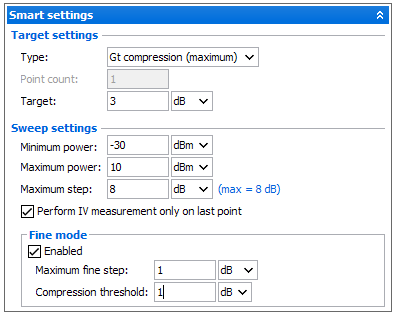
- Target settings
- Type: select the target to reach (it could be a gain compression or a power level)
- Point count: (available only in linear gain compression mode) set the number of point to compute the average level of the linear power
- Level: set the target level to reach
- Sweep settings
- Min/Max power: set the power range authorized for the optimization
- Maximum step: set the maximum power step achievable between two
pointsNote: When the gain compression is selected as target, the algorithm is based on the gain slope. First step will be equal to the maximum step, then this step will decrease in function of the gain slope value.
- Perform IV measurement only on last point: check this box in
order to speed up the measurement by measuring the IV performance only
at the target level and not for each power levelNote: In this case, no post measurement interpolation will be possible.
- Fine mode
Basic mode using coarse step can lead to an overdrive of the DUT.
With the fine mode, more iterations are used as the gain becomes closer to the target compression point, which minimizes excess drive power.
- Maximum fine step: define the maximum step size achievable when the threshold of fine mode is reached
- Compression threshold: set the value of gain compression to trigger fine mode

